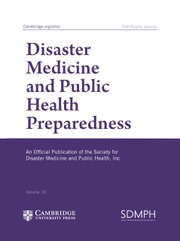No CrossRef data available.
Article contents
Phenomenological Analysis of Factors that Affect the Increase in the Willingness to Reengage Volunteer Rescuers and Saviors of the Red Crescent Society of the Islamic Republic of Iran
Published online by Cambridge University Press: 31 October 2024
Abstract
The present study aimed to analyze the factors that influence the increase in the desire to re-engage volunteer rescuers and saviors of the Red Crescent Society of the Islamic Republic of Iran.
This qualitative descriptive phenomenological study involved the participation of volunteers who had not volunteered in the Iranian Red Crescent Society (IRCS) for at least one year but expressed a willingness to be re-engaged. The semi-structured in-depth interview process and data collection continued until the theoretical saturation stage was reached. The collected data was analyzed using the interpretive approach and the 7-step Claesian method.
The results show that several factors influence the increase in the desire to reengage volunteer rescuers and members of IRCS. These factors were categorized into 136 codes, 63 main codes, 20 clusters, 7 classes, and 3 themes, namely “organizational support and understanding,” “work characteristics,” and “organizational credibility.” The results of the study indicate that each of the identified factors plays a significant role in the dynamics of the re-engagement process for rescuers and volunteer rescuers within the IRCS.
The experiences of volunteer rescuers and members can be utilized to enhance the recruitment and retention of volunteer human resources within the IRCS.
- Type
- Original Research
- Information
- Copyright
- © The Author(s), 2024. Published by Cambridge University Press on behalf of Society for Disaster Medicine and Public Health, Inc


